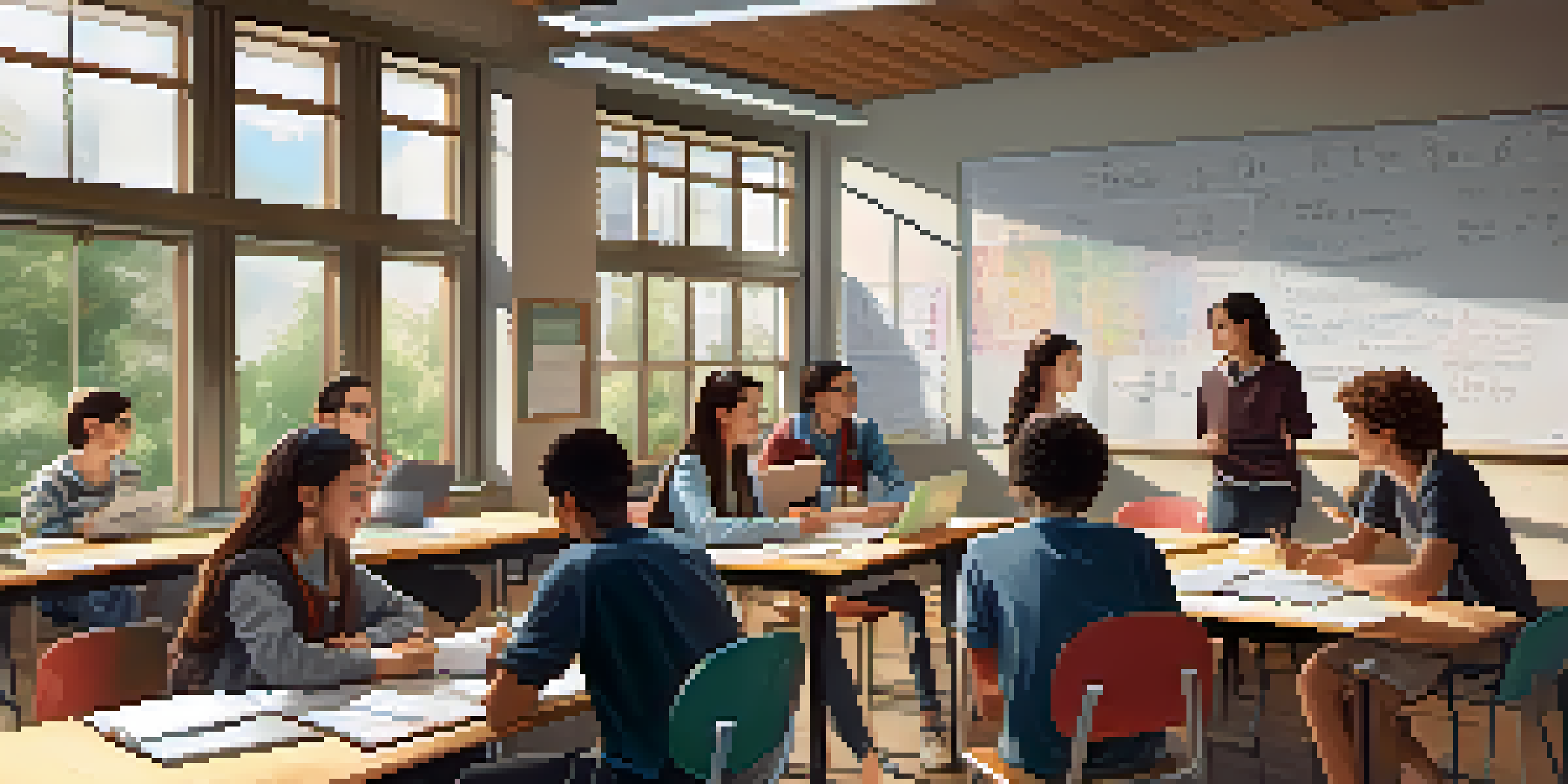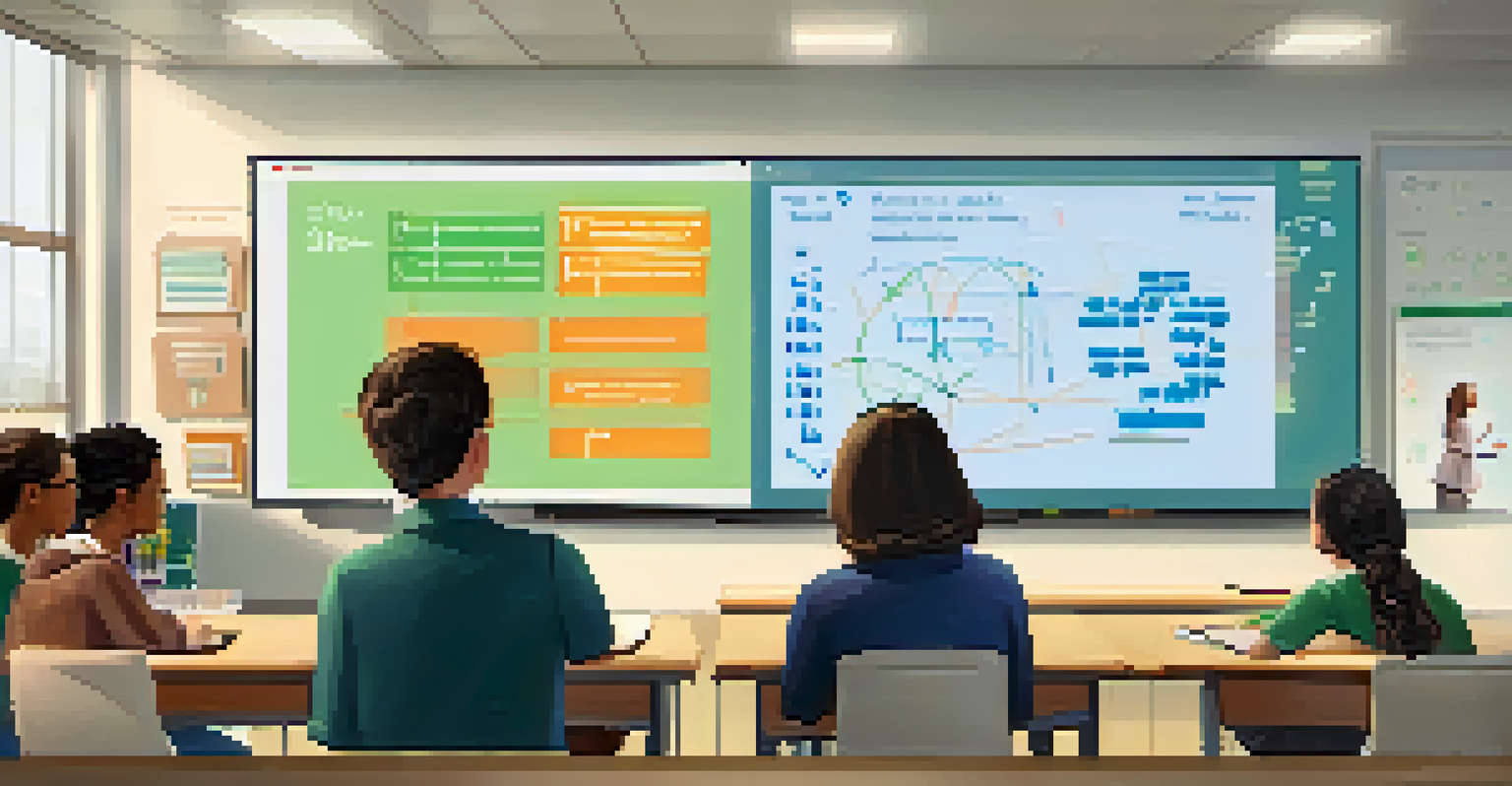Flipped Classrooms: A Trend in NYC Education

Understanding the Flipped Classroom Model
The flipped classroom model is an innovative educational approach that shifts direct instruction outside the classroom. Instead of traditional lectures, students engage with video lessons or online content at home. This allows class time to be dedicated to hands-on activities, discussions, and collaborative projects, enhancing the overall learning experience.
The best way to predict the future is to create it.
Imagine coming to class having already watched a tutorial on algebra. Instead of listening to a teacher explain concepts, you dive right into problem-solving with your peers. This method encourages active participation and allows teachers to offer personalized support during class time, making learning more interactive and effective.
With the rise of digital resources, flipped classrooms are becoming more accessible. Schools in New York City are beginning to adopt this model, recognizing its potential to cater to diverse learning styles and pace. It's a shift that not only empowers students but also transforms the role of teachers into facilitators of learning.
Benefits of Flipped Classrooms in NYC
Flipped classrooms offer numerous benefits, particularly in a bustling city like New York. One significant advantage is the flexibility it provides for students. They can learn at their own pace, replaying videos and revisiting materials as needed, which is especially helpful in a diverse classroom setting.

Additionally, this model encourages deeper engagement with the subject matter. Students who might hesitate to ask questions during a lecture feel more comfortable seeking help during interactive class sessions. This fosters a collaborative learning environment where students can support one another and build confidence in their abilities.
Flipped Classrooms Enhance Learning
This innovative model shifts instruction outside the classroom, allowing for more collaborative and personalized learning experiences.
The flipped model also allows teachers to use class time for more personalized instruction. Instead of delivering the same lecture to every student, educators can tailor their approach based on students’ needs, making learning more relevant and impactful. This adaptability is crucial in meeting the varying demands of NYC's student population.
Challenges Facing Flipped Classrooms
While the flipped classroom model has many advantages, it's not without its challenges. One major hurdle is ensuring that all students have access to the necessary technology at home. In a city as diverse as New York, not every student has the same level of resources, which can create disparities in learning opportunities.
Technology will not replace great teachers, but technology in the hands of great teachers can be transformational.
Furthermore, some students may struggle with the self-directed nature of flipped classrooms. Not everyone is accustomed to taking initiative in their learning, and without proper guidance, they might fall behind. It’s essential for educators to provide clear instructions and support to help students transition to this new learning style.
Lastly, teachers need to invest time in creating high-quality instructional videos and materials. This preparation can be overwhelming, especially for those who are already juggling multiple responsibilities. Providing teachers with professional development and resources can help alleviate this burden and ensure successful implementation.
Real-World Examples of Flipped Classrooms in NYC
Many schools in NYC have successfully implemented the flipped classroom model, showcasing its effectiveness. For instance, a local high school adopted this approach in their science department, leading to improved student comprehension and engagement. By using video lessons and interactive lab sessions, students have reported feeling more prepared for exams.
Another example is a middle school that flipped its math classes. Students watch instructional videos at home and then collaborate on problem-solving during class. Teachers noted a significant increase in participation and a decrease in math anxiety, as students felt more confident in tackling challenging concepts together.
Challenges Include Tech Access
Not all students have equal access to technology at home, which can create disparities in learning opportunities.
These success stories illustrate the potential of flipped classrooms to enhance learning experiences across various subjects. By sharing these real-world examples, other educators can see the tangible benefits and consider adopting similar strategies in their own classrooms.
The Role of Technology in Flipped Classrooms
Technology plays a crucial role in the success of flipped classrooms. The use of educational platforms and video tools allows teachers to create engaging content that students can access anytime, anywhere. This flexibility is vital in a city where students often have busy schedules and varying commitments outside of school.
Moreover, technology enables teachers to track student progress and engagement effectively. With analytics tools, educators can identify which videos are most effective and where students might be struggling. This data-driven approach allows for timely interventions and adjustments to teaching strategies, ensuring that no student is left behind.
However, it's important to remember that technology should enhance, not replace, traditional teaching methods. The best flipped classrooms strike a balance, integrating technology with personal interaction and hands-on activities. This hybrid approach maximizes learning potential while maintaining meaningful connections between students and teachers.
Future of Flipped Classrooms in NYC Education
As the educational landscape continues to evolve, the flipped classroom model is likely to gain even more traction in NYC. With ongoing advancements in technology and a shift toward student-centered learning, educators are increasingly recognizing the benefits of this approach. Schools are already investing in the necessary resources and training to support this innovative model.
Moreover, the COVID-19 pandemic has accelerated the adoption of digital learning tools, making it easier for schools to implement flipped classrooms. The experience has highlighted the importance of flexibility and adaptability in education, further solidifying the role of flipped classrooms in the future.
Technology is Key to Success
Effective use of educational technology enables teachers to create engaging content and track student progress.
Ultimately, the future of flipped classrooms in NYC education looks promising. As more educators share their successes and challenges, a collaborative community will emerge, fostering continuous improvement and innovation in teaching practices. This evolution will not only benefit students but also empower teachers in their mission to create engaging and effective learning environments.
Getting Started with Flipped Classrooms
For educators interested in transitioning to a flipped classroom model, starting small is key. Begin by selecting one or two lessons to flip, creating or curating video content that aligns with your curriculum. Consider using free resources or platforms that simplify video creation, making it accessible to all teachers, regardless of technical expertise.
Next, communicate with students and their families about the new approach. Providing clear instructions and resources ensures everyone is on board and knows what to expect. Encouraging feedback from students can also help refine the process and make adjustments as needed.

Finally, be patient and flexible during the transition. Like any change in teaching style, it takes time to adapt and learn what works best for your classroom. Embrace the journey, celebrate small successes, and continue to seek out professional development opportunities to enhance your flipped classroom strategies.